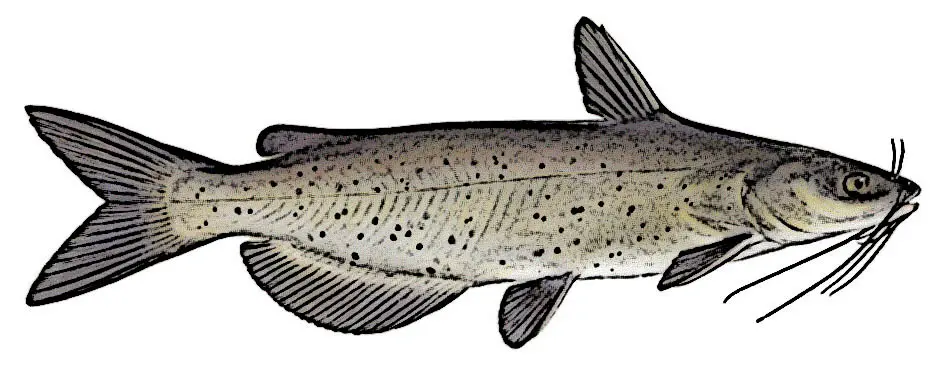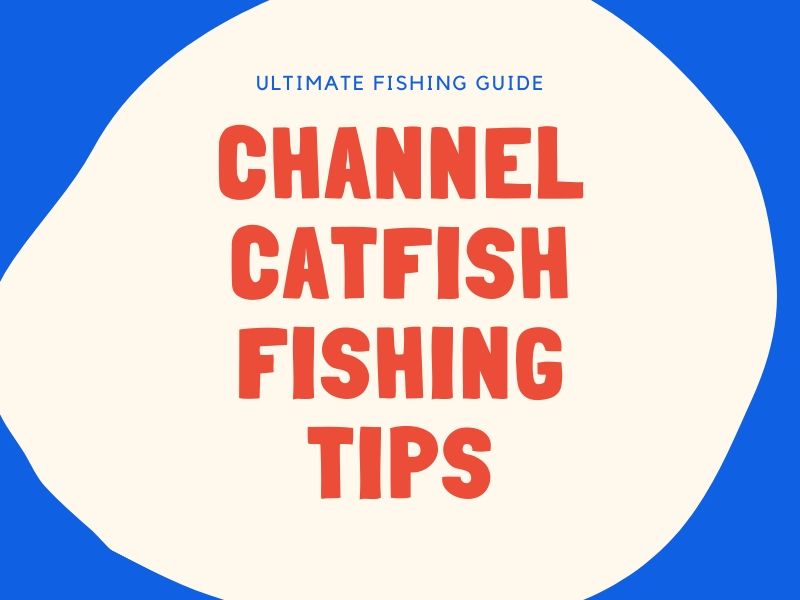Channel catfish are the most popular catfish to target in North America. They are the most abundant catfish species in North America and can be caught in most states in the Midwest to Eastern regions of the United States.
If you’re going fishing for channel catfish, you need to read this guide. We will cover how to identify them, where to fish for them, their seasonal patterns, the equipment you will need, and give a few extra tips to help you catch more of them.
Channel Catfish Identification
You can recognize channel catfish by their wide flat heads and deeply forked tails. Some of them also have an irregular spotted pattern, though this is more common in smaller catfish. The body of a channel catfish is usually a pale olive to a pale blue color with a silver tint, though the color may vary slightly from location to location. They also have long mouth barbels (whiskers) like other catfish.

An average most catfish you will catch will end up weighing in the 2 to 7 pounds. Though they can reach giant proportions. If you catch one over 15 to 20 pounds that would be a very large catfish. The world record was a 58 pound mammoth of a catfish caught in 1964.
Where to Catch Channel Catfish
Channel catfish are a freshwater species that are found in lakes, reservoirs, ponds, streams, and rivers. They are usually found in clear slower-moving waters with gravel bottoms. Sand bottoms are also good spots to look.
What Do Channel Catfish Eat?
Channel catfish primarily eat smaller fish, clams, snails, insects, and crayfish. What they regularly eat will depend largely on the available food in the waters that inhabit.
Seasonal Patterns
Fall
As the temperatures begin to drop channel catfish will start to aggressively feed as they prepare for the winter. This can be a great time to catch them. The temperature drop will cause channel cats to begin their movement from shallow waters to deeper waters.
When the weather just starts dropping, you can still find channel catfish near weedflats before they move into the transition zones. As the temperature starts getting lower they will move to depths between 6 to 15 feet just outside shallow flats. Look for soft bottomed areas just outside flats that lead down into basins.
As the cold settles you will have to look in the basins. Fish the areas around the 15 to 40-foot depth in larger lakes. In shallow lakes and reservoirs fish the deepest hole you can find.
Winter
In the wintertime, channel catfish will remain in the deepest holes. They often return to the same spots as previous years, so if you had a lot of success fishing one section the year prior, return to the same area, and you may find it very productive.
If you’re fishing rivers, look for holes outside hard bends or steep banks. Otherwise in lakes and reservoirs search areas ranging from 15 to 40 foot deep. Just remember to use a slower presentation in the cold. Everything moves slower in winter, so you need to match the tempo of the water to have the most success.
Spring
In the springtime, many anglers like to fish ponds for channel catfish. This is because the water warms up faster and the catfish are drawn to the shallows where they can be more easily caught. Shallow muddy flats are known to warm up faster than the surrounding waters, so this is the prime spot to look.
You can also find ideal spring locations where rivers meet lakes and reservoirs. These areas will be shallow and muddy, which makes them great spots to try.
Summer
In the heat, channel catfish will return to the deepest areas of the lake, river, or reservoirs they inhabit. In the day you will have to fish the deep sections, though they will come out at night to feed in the shallows. The catfish can feed aggressively both day and night, but often there are moments of aggressive feeding, followed by a slowing period where they won’t be biting as often.
Best Time To Catch Channel Catfish
Though channels can be caught pretty much year-round, summer is the favorite season for many anglers. Particularly summer evenings and nights when they aggressively feed in the shallows is one of the best times to target them.
Channel Catfish Fishing Equipment
Rods and Reels
Since channel catfish can vary greatly in terms of size, the best kind of rod ultimately depends on the size of the fish you are targeting. For smaller catfish, a medium to medium-light spinning rod is a great choice. But if you’re after monster channel catfish you may want a medium-heavy spinning rod. Just make sure the rod is around 7 feet in length and can handle abuse from fighting a large fish. You will also want to use a heavier spinning reel for targeting catfish.
Baitcasting rods and reels are also a favorite of many anglers targeting heavier fish. In fact, these are the most commonly used. Baitcasting reels often have heavier build and are better for larger catfish.
If you’re looking for a good recommendation, Ugly Stik Catfish Rod and Reel Combos are widely used. These are the most common among anglers targeting channel catfish.
Lures and Baits
Stinkbaits
Stinkbait is one of the tried and true bait choices for catching channel catfish. This smelly stuff tends to work great for bottom-feeding catfish. There are a variety of different kinds of stinkbait, each which has its own strengths.
The most popular for catfish are dough bait, squeeze bait, punch bait, and dip bait. Dough Bait is best to use in faster moving waters because it won’t get pulled off in the water. Squeeze is good in slower-moving waters because the smell can travel long distances to attract fish. Punch bait is good for lakes and ponds with still water. Dip bait can work in almost any water, but work best in lakes or reservoirs when you need to cast long distances.
In-line spinners
Though most anglers prefer to use live bait or smelly stinkbait to catch channel catfish, an in-line spinner can work well too. Use blade sizes #2 and #3 and cast them along shorelines if you’re fishing river channel cats.
Jigs
Jigs are a good choice because you have precise control over your presentation. Catfish usually are feeding on the bottom or just off the bottom and with a jig you can control exactly where you want to place it. If you’re fishing deeper lakes and reservoirs slip sinker rigs and three-way rigs are commonly used.
Live or Dead Bait
Live bait is often the best option for catching catfish. Try to use something that the channel cats are already eating in the water they inhabit. Shad is very commonly used, and so is other smaller fish like bluegill and other sunfish. You can also use worms, crickets, grasshoppers, and crayfish.
Fishing Line
Channel catfish anglers will commonly use monofilament, braided, or fluorocarbon fishing lines depending on the situation and their personal preference. A good 20 to 30-pound test mono line should work well for catfish up to 20 pounds in weight.
Braided line can be better for fishing faster moving waters because the line is thinner and cuts the water better. Something around a 65-pound test braided line would be a good choice for most channel catfish.
Fluorocarbon is a popular leader choice for catfish. But many anglers also opt for mono as leader. No matter what kind of line you choose, you will probably want a fluorocarbon or monofilament leader line.
Hooks
The most commonly used are circle hooks and treble hooks for channel catfishing. For treble hooks stick with a size #2, #4, #6, or #8.
For circle hooks, the best size is a 2/0 or 3/0, though if you are fishing smaller catfish you can use a 5/0 or 6/0
Channel Catfish Fishing Tips
Catfish are Bottom Feeders
Channel catfish, like most catfish, are bottom feeders. They will either be right on the bottom, or just above it. So you will need to keep your presentation near the bottom for optimal results.
Smelly Baits
Channel catfish are also scent oriented feeders. That is why natural baits and stinkbaits are preferred. You can even tip your jigs to increase their effectiveness. Try tipping with a small live worm or minnow.
Use the Appropriate Size
We all dream of landing a monster cat, but sometimes the odds are not in your favor. If you use too heavy of gear to go after larger fish, you may not get any bites. Smaller catfish will not bite if your gear isn’t the right size.
Try Fishing the Dark
Sometimes fishing night time can be even more productive than day fishing. Summer evenings and nights you might find them coming out and feeding more aggressively than during the day time. If you can muster up enough strength to stay out into the dark, you might have a very productive day.
Related Posts:
Bullhead Catfishing Tips
How to Catch Northern Pike
